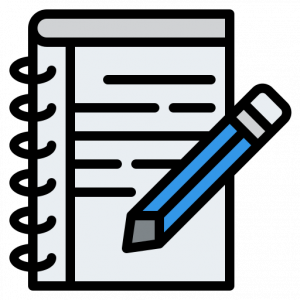Module 02: Me voici!
Deuxième Partie: La famille et les amis, Explication de grammaire
In this section:
-
Possessive determiners
-
Intro to Adjectives
-
Placement of adjectives
Possessive Determiners


forms and uses
The possessive determiners serve to express ownership or possession (hence the name). They are also often called possessive adjectives because they agree in gender and number with the noun they introduce.
| Masculine singular |
Feminine singular |
Plural Non-binary | Translation |
| mon | ma | mes maon | my |
| ton | ta | tes taon | your (familiar) |
| son | sa | ses saon | his, her, their or its |
| notre | notre | nos | our |
| votre | votre | vos | your (formal or plural) |
| leur | leur | leurs | their |
![]()
 Possessive articles, like all articles, must agree with the noun they modify. Thus, if the noun is feminine, the possessive article must be feminine, too. In the following example, the feminine noun famille requires a feminine form – sa. Note that sa has three potential translations in English: ‘his,’ ‘her,’ or ‘its.’ So, how do you know which meaning is intended? Context! Since the following example sentence refers to Tex, we know that sa means ‘his.’
Possessive articles, like all articles, must agree with the noun they modify. Thus, if the noun is feminine, the possessive article must be feminine, too. In the following example, the feminine noun famille requires a feminine form – sa. Note that sa has three potential translations in English: ‘his,’ ‘her,’ or ‘its.’ So, how do you know which meaning is intended? Context! Since the following example sentence refers to Tex, we know that sa means ‘his.’
![]()
| Sam présente sa famille: Voici mon frère, Trey, et ma soeur, Rita, avec ses enfants et leur chien Fido. Notre famille est formidable! | Sam introduces his family. Here is my brother, Trey, and my sister, Rita with her children and their dog Fido. Our family is great! |
![]()
liaison
Do not forget to make the liaison between the plural forms of the possessive determiners and words that begin with a vowel sound. Ma, ta, sa become mon, ton, son in front of feminine nouns beginning with a vowel sound.
![]()
Tex continues his introductions:
| Sam: Voici Tammy, mon amie, et ses amies Sophie et Fiona, c’est-à-dire nos amies. | Sam: Here is Tammy, my friend, and her friends, Sophie and Fiona, that is to say, our friends. |
![]()
Listen to the dialogue:
![]()
| Sacha parle avec Sophie:
Sam n’est plus mon ami! Il a complètement oublié mon cadeau et notre anniversaire! Il a oublié toutes ses promesses! Quel nul! |
Sacha is talking with Sophie:
Sam is not my friend any more! He completely forgot my present and our anniversary! He forgot all his promises. What a loser! |
Non-binary options:
As mentioned previously, non-binary language continues to evolve and many forms exist. We have chosen to include the options suggested by Dr. Kris Aric Knisely.
maon, saon, taon
Intro to Adjectives

Describing friends and family
An adjective is a word that describes a noun or pronoun. The major differences between adjectives in French and English concern agreement and placement. In French, an adjective is usually placed after the noun it modifies and must agree in gender and number with the noun. In English, an adjective usually comes before the noun it modifies and is invariable, that is, it does not agree.
![]()
| Sam est un étudiant philosophique. | Sam is a philosophical student. |
| Eliott est un surveillant raffiné. | Eliott is a refined monitor. |
| Edouard est un professeur aimable. | Edouard is a friendly professor. |
| Sophie est une présidente capricieuse. | Sophie is a temperamental president. |
| Caleb est un délégué désagréable. | Caleb is an unpleasant representative. |
| Fiona est travailleuse. (f) | Fiona is hard-working. |
| Mais Edouard n’est pas travailleur. (m) | But Edouard isn’t hard-working. |
adjective vs. adverb
It is common in nonstandard English for speakers to use adjectives in place of adverbs.
| Edouard says: “Gee, Sam writes real good.” (instead of: “Sam writes well.”) |
| Sam says “Gosh, Eliott, you walk real slow.” (instead of: “Eliott, you talk slowly.”) |
![]()
French adjectives are rarely used in place of the adverbial form. Remember that adjectives modify nouns and adverbs modify verbs, adjectives, and other adverbs!
| Sam écrit bien. (adverb modifies verb) |
Sam writes well. | |
| La poésie de Sam est bonne. (adjective modifies noun) |
Sam’s poetry is good. |
Placement of Adjectives

| 1. | formation | |
| 2. | placement |
![]()
formation
Adjectives agree in both number and gender with the noun or pronoun they modify. For regular adjectives the masculine form is the base form to which endings are added. The feminine adjective is formed by adding an e. The plural adjective is formed by adding s. Listen to the recorded examples to hear the pronunciation of the different adjective forms:
![]()
|
Note how the singular and plural forms of the masculine adjective sound the same, and the singular and plural forms of the feminine adjective also sound the same.
![]()
|
|||||||||||||
The adjective takes the masculine plural when the nouns it modifies are of different genders: Tammy et Tex sont petits. (Tammy and Tex are little.)
Irregular adjectives do not follow the rules given above.
![]()
placement
In French, most adjectives follow the noun, unlike in English, where the the adjective precedes the noun. Here are some examples of adjectives following the noun:
|
Note that there is a small group of adjectives that normally precede the noun. Some adjectives can also be placed before or after the noun but changing the position of the adjectives can modify their meaning.
![]()
Listen to this dialogue:
|
|||||||||||||


